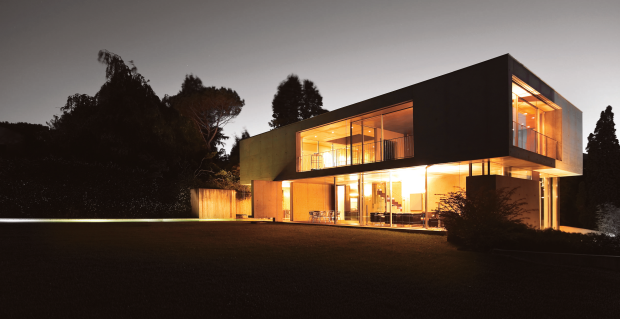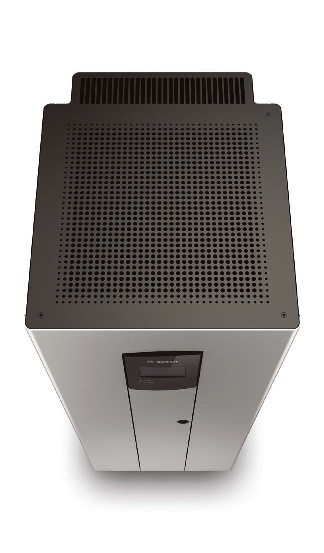Just over the horizon, a new tsunami is quietly gaining momentum, in the guise of solar storage, or 'hybrid solar'.
Australia has over 1.1 million rooftops adorned with solar panels, providing about one per cent of the nation's electricity needs. One might not expect such a seemingly tiny proportion of power generation to ruffle any feathers, but this grassroots groundswell of decentralised power production is making the major energy utilities nervous. The likes of Origin and AGL Energy have recently advocated for the removal of rooftop solar subsidies.
The installation of photovoltaic solar electricity panels on household and business roofs may have energy utilities concerned over their eroding share of the electricity market, but, to paraphrase the 70's rock band Bachman-Turner Overdrive, 'they ain't seen nothing yet.'
 Hybridhaus with energy by Bosch BPT-S5 Hybrid (storage unit pictured below)
Hybridhaus with energy by Bosch BPT-S5 Hybrid (storage unit pictured below)
Solar power first gained modest momentum as a source of energy for those philosophically opposed to, or geographically disadvantaged by, the grid: that network which allows power plants to connect users with electricity generated from the likes of coal or hydro.
These off-grid folk needed large battery banks to provide power when the sun didn't shine. And often diesel generators, as a back-up, when the batteries lost all their stored sunlight. Such users had to be quite energy savvy to maximise the efficiency of their systems.
 Conversely, when grid-connect came along, it was mostly 'plug-and-play'. No user-involvement required. Panels on the roof, inverter on the wall, and forget about it. Except for the rapturous reduction in ongoing energy costs.
Conversely, when grid-connect came along, it was mostly 'plug-and-play'. No user-involvement required. Panels on the roof, inverter on the wall, and forget about it. Except for the rapturous reduction in ongoing energy costs.
Solar hybrid, is, just as the name suggests, an alchemy of the two systems noted above. Grid-connected photovoltaics and battery storage.
It opens the way to every home having their own genie (free solar energy) and a bottle (battery bank) to house it in. Make a wish and the genie leaps to their bidding.
Interest in the combination has piqued due to the ever changing nature of the Australian energy market. Grid-connect solar attracted early enthusiasm due to feed-in tariffs, when householders were well paid by utilities for the power they contributed back to the grid.
However just as tariffs were being wound back, utilities began raising prices to pay for years of neglect in infrastructure investment. Into this 'perfect storm' of disappearing solar rebates and increasing grid bills, rode solar storage.
And like all heroes it promises to help the little folk stand up against entrenched power brokers.
Hybrid solar generally uses a smart inverter that will send power directly to a home's needs as the sun beams down.
Any excess to household requirements can be shunted either to the grid (to benefit from feed-in tariffs), or to the system's battery bank for evening and morning use. Some of these battery banks, mostly about the size of a fridge, can also draw power from the grid during 'off-peak' period and store it for use later when the grid has moved to peak.
During a blackout--when the grid is offline--the inverter channels power from the battery to pre-designated 'essential circuits' to keep the likes of lights, fridges and freezers running. Solar storage systems can be retro-fitted to pretty much any home solar configuration. (They can even be used for residences without photovoltaic panels, as householders can benefit from accessing just off-peak electricity.) These, and other, energy routing permutations can all be managed automatically, in the background, as the household goes about its usual routines.
At this year's Greentech Solar Summit Conference in the USA, Jim Morgensen, director of strategic accounts at SMA, (a 30 year old German solar company), said hybrid solar storage is a hot topic, while speculating that the cost of the storage devices could be coming down even faster than that of the typical PV curve witnessed in recent years.
Hot topic indeed. In March 2014, the Clean Energy Council published a discussion paper on the decentralising of Australia's energy supply, remarking:
"For the moment it would seem more likely that households will stay on the grid, but that the role of grid-supplied power will be inverted, from the primary source of power (supplemented by embedded generation like solar PV) to a safety net supplier of last resort, with embedded generation being the primary source of power."
Pause for second. And consider that observation. Australian homes to become the "primary source of power" of their own electricity. How about that for a seismic shift in thinking about the residential housing sector?

